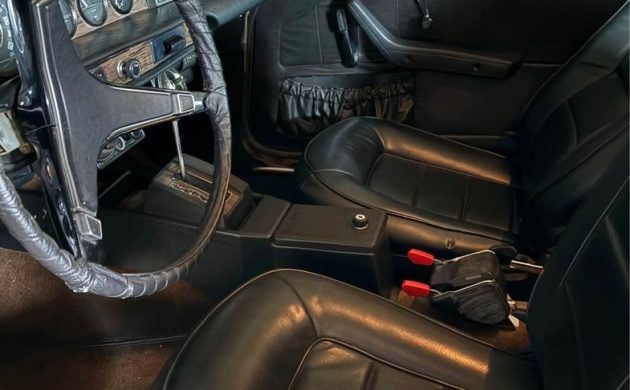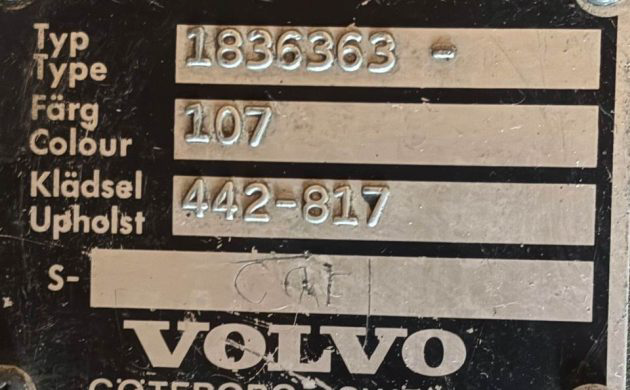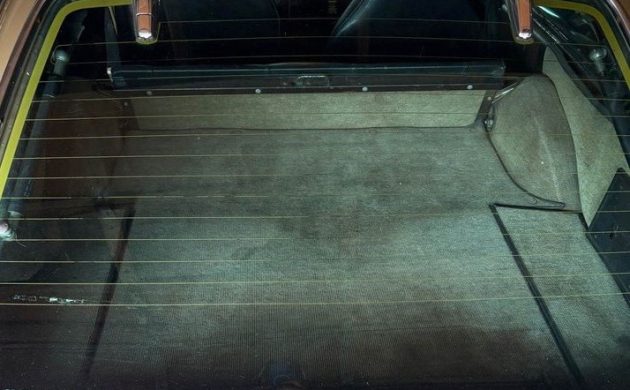Sporty Shooting Brake: 1972 Volvo 1800 ES
We’re told very little about this 1972 Volvo 1800 ES sporting station wagon here on Facebook Marketplace in Henderson, Nevada. It “runs well and is in good shape.” And darned if that doesn’t appear to be true. The ES has 83,457 miles, an automatic transmission (with a nice wooden knob), and is an unfashionable gold in color. The car is being sold as part of an estate sale and can be viewed as of November 8. Thanks to T.J. for the tip.
The photos aren’t all that forthcoming, but the ES definitely has a very nice interior with what appear to be freshly reupholstered seats in leather. The body looks nice enough. Engine photos are missing, as are undercarriage shots. The dry Nevada desert air appears to have been kind to the car. It might be original paint, as the ES was offered in this color.
The ES was, of course, an offshoot of the lovely 1800 coupe, first offered in 1961, and then produced in England by Jensen and Pressed Steel. This arrangement proved unsatisfactory, and production was shifted to Sweden in 1963, which explains the tail badge “1800S.”
The ES (injected, built in Sweden) wagon variant was first seen in 1971, and the museum in Goteborg contains a fascinating prototype built on the earlier 1800S rather than the later, fuel-injected 1800E introduced in 1970. Americans could buy the ES with that fetching glass tailgate only in 1972 and 1973. Both automatic and four-speed manual plus overdrive versions were offered.
Britons (sometimes) call these cars “shooting brakes.” Sporty wagons, made by BMW, Audi, and Mercedes, among others, never gained huge followings in the U.S. but have their adherents. The ES is a highly regarded example of the form. Both Pietro Frua and Sergio Coggiola produced prototypes that were ultimately rejected, and Frua’s “Raketen” (The Rocket) is in the museum. I agree. The concept is kind of ungainly. The finished product was turned out in-house by Jan Wilsgaard.
The ES got a 125-horsepower B20F four-cylinder engine, and they’re fun to drive, but ever so slightly ponderous (especially in Borg-Warner three-speed automatic form).
The small back seat folded to create a useful loading area. However, despite being cute and practical, Volvo discontinued the model because American safety laws would have required a redesign in 1974. Just 8,077 were built, though they have a reasonably high survival rate. They’re Volvos, after all.
The $18,000 asking price for this 1800 ES is not out of line, considering that their average price on Classic.com is $21,374. But most of the examples sold are well documented, often with rebuilt powertrains and extensive bodywork (they rust terribly, even without Jensen involved). This one seems to have had work done, but the seller is likely unfamiliar with selling cars like this. A little information goes a long way. More and better pictures would also help.
Auctions Ending Soon
 1979 Chevrolet Camaro Z/28Bid Now7 hours$7,000
1979 Chevrolet Camaro Z/28Bid Now7 hours$7,000
 1960 Dodge D300Bid Now8 hours$800
1960 Dodge D300Bid Now8 hours$800
 2006 Ford Mustang Saleen S281 SCBid Now2 days$15,000
2006 Ford Mustang Saleen S281 SCBid Now2 days$15,000
 2002 Subaru Impreza WRXBid Now5 days$100
2002 Subaru Impreza WRXBid Now5 days$100










Comments
I fell in love with the coupes as a little kid. ( back when you’d actually see them running and driving on a faily basis) when I first saw these, I wasnt a huge fan, but now older I like them. If it had a stick, Id be way more interested. But thats just me. Feom what you can see the seats look good and I think the dash looks good too. And even the gold I could live with.
These are really cool but the 3-speed BorgWarner slushomatic transmission takes a lot of the fun out. Is that an underdash air conditioner visible in the 4th photo?
Good shot of the AC on the Facebook ad.
And now pops up a picture of the AC unit….
Yes, that is the “factory” underdash a/c, which was a dealer-installed unit. Mercedes had the same approach. Living near the arctic circle, Europeans had little appreciation for a Florida or Texas summer
Always preferred these to the coupes-IMO they look better without the “tail fins”. Too, never saw anyone with the auto driving one that was smiling like they were enjoying the ride, unlike it seemed everyone else driving them with 3 pedals under the dash.
The seats in these ES cars are really poofy compared to the earlier coupe models; not sporty looking. The dash has the worst looking fake wood; gone are the nice looking chromed Smiths gauges with green faces. And that 3-spoke steering wheel is lame compared to the earlier 2-spoke wheels.
I like those early seats, but the later ones are more contoured to the body, have integrated head rests, and I suspect superior crash protection.
Agree with you on the fake wood……but it was the 1970s. Living in Florida, the alure of real wood is reduced by the nightmare of refinishing or replacement
One of my top 5 best designs. If I could have gotten the color I wanted I’d have bought one in late ’72. “A beautiful Apple Green” just didn’t get it for me.
Everybody wants to blame the feds for everything, but that is not the case with this car.
The ES was a last-ditch attempt to modernize a car that dated from the Ghia “Supersonic” series of 1953.
Volvo had actually designed a replacement for this car designed by Coggiola, in Italy.
It conformed to federal bumper standards and used the existing platform.
The existing mechanicals with a four-cylinder and four speed/overdrive was no match for the brand new 240 Z and more modern competitors.
Even redesigned for changing market conditions, the car was deemed to be too heavy and expensive to compete with Japanese sports cars, and Volvo canceled its plans.
It’s always fun to blame the feds for everything (and sometimes they deserve blame) but in this case, marketing a heavy, obsolete, and very expensive automobile against fresh sophisticated modern competition was a bad marketing move and Volvo recognized this
I have a 1973 1800 ES. It is a delightful car, but Volvo made the right decision.
along w/the one below it in the thumbnail/today’s frnt page I place these highly (MGB GT, similar). So there’s some disagreement. (“…never gained huge followings in the U.S…”) Still friends tho, eh?
Auto’s ok (a BW most dont like) w/me as I’d daily not auto cross. As a constant driver of older vehicles I no U need to customize driving w/each. It’s part of the fun of driving, then rest0moding (or not) and driving on~
From what I have read, potential customers were “confused” by the sportwagen concept. They just couldn’t figure out if it was a sports car, or a family station wagon.
Only about 8,000 of these were made in the 1972 and 1973 model years.
A beautiful design from Pietro Frua at Ghia with Peter Petersen of Volvo. Built the old carrozzeria way, with steel panels hammered individually over wooden bucks. A very expensive way to make a car.
When Toyota did a near copy called the Corolla Liftback, the inspiration is clear, but all of those expensive curves were replaced by straight lines and flat panels.
Is that a crease in the hood on the passenger side? (kind of like the crease that could develop on the early ’70’s Chevy trucks if the hinges were not maintained.)
I have always liked the ES wagons since they came out. Nearly purchased one in the late 80’s.
Looks like the hood edge follows the same contour. The top of the fender is what might be dipped in that area. Either way it’s too noticeable to ignore.
It does look like a damaged hood. The hood’s hinges are known to get sticky with age, and problems can happen if they are not periodicaly lubricated.
The hood is bent. Looks like someone tried to close it without releasing the “hood holder opener”.
Paint is not original. The rocker panel seams are filled.
The unlubed, rusted hood hinges will tear the area of the hood around the hinge attachment.
This one is local to me, so it was in my FBM feed before I saw it here. I owned one once. I think this price is optimistic for an automatic car without documentation. It’s already gone down $2k since it was posted.
i remember some years ago a movie named ‘crazy people’, i think it had darrel hannah and dudley moore as folks in a crazy hospital that helped increase sales of the volvo from a sales pitch they came up with, something like ‘they ugly but they are good’, and sales took off… i kinda remember that movie…